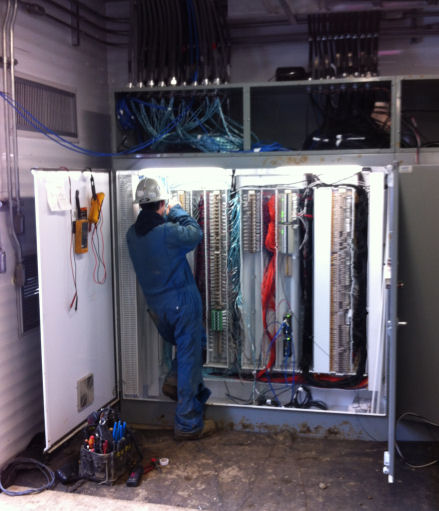Maintenance Electrician Job Overview
A maintenance electrician usually works in factories, schools, hospitals, gas plants or other large commercial establishments. The electrician is responsible for keeping the generators, lighting, and electrical systems in good working order. He must diagnose problems and make necessary repairs or replace defective parts.

An electrician will spend most of his time on preventive maintenance. Your day will consist mainly of inspecting equipment for potential problems before a costly breakdown can occur. Specific duties will depend on the size of the building you work in and the nature of the business.
In factories, you are responsible for keeping all equipment and machinery running smoothly. In hospitals or large office buildings, you will be responsible for keeping all lighting systems, climate control units and alarm systems working properly. And electricians working in public utilities or mining industries must make sure the generators provide a constant and reliable flow of electricity.
As a electrician, you will regularly test various types of electrical equipment and replace faulty circuit breakers and worn-out switches. In some cases, you may be required to repair wires by splicing in a junction box or cutting conduit. Conduit is the metal tubing used to keep wiring in place and safe from outside elements.
You will use drawings, blueprints or circuit schematics to plan your work and make repairs. The drawings or blueprints are usually designed by advanced electricians or engineering electricians. The most common tools you will use are screwdrivers, wire cutters, pliers, knives, conduit benders, drills and testing equipment such as a multimeter and a clamp-on amp meter.
When a breakdown occurs, you need to act quickly, especially in a factory setting. Every minute the machines are down, the company loses thousands of dollars. Not only is production stopped, but the company must also pay workers to sit around and wait for the machinery to be fixed. That is why knowing the machinery inside out is so important. You must be able to quickly and accurately diagnose the problem and identify what it will take to fix it and how long it will take you to make the necessary repairs.
Training to be a Maintenance Electrician
The best way to train as a maintenance electrician is by enrolling in an apprenticeship program. To apply, you will need to have a high school diploma or GED. Your chances of being accepted will be greatly increased if you took shop, algebra, physics and trigonometry in high school.
You must be physically fit and in good health, have a good level of manual dexterity and be relatively good at math. You must also be able to identify colours. The functions of electrical wires are usually designated by colour, so you need to be able to tell them apart.
A four year apprenticeship program consists of 144 hours of classroom training and about 1,800 hours of on-the-job training per year. In the classroom, you will learn mathematics, electrical theory, wire splicing, motor repair, welders and how to repair circuits and electrical controls. On the job, you will get hands-on experience with various materials and tools you will be using in the field. You will also learn how to diagnose and solve electrical problems.
The best part about an apprenticeship is that you get paid while you learn. Another way to get paid while in training is to work as an electrician’s helper. However, most employers prefer someone with a formal apprenticeship. Most regions require an electrician to be licensed. To become licensed, you must pass an exam to test your knowledge of electricity, knowledge of the Electric Code and of building regulations.
Landing the Job
An apprenticeship program is a great way to land the job you want. If you are lucky enough to apprentice with the company you want to work for, there is a very good chance they will keep you on full time once your training is complete. After all, they just invested four years of their time and money training you, it only makes sense that they would want to keep you.
However, some companies take on apprentices solely for the purpose of training. After you are licensed, it is up to you to find a job or start your own business. As an apprentice you also have access to many companies. These powerful connections make getting a job much easier.
Possibilities to Advance
Once you complete your apprenticeship and pass your final exam, you are at the top of your trade, but there is still room for advancement. An experienced maintenance electrician in a factory can become a plant maintenance supervisor or superintendent. Or you can can enter into a related job in sales, purchasing, estimating, inspecting or contracting. A maintenance electrician may also work as construction electrician installing wiring in new developments.
Maintenance electricians are always in demand. As long as the population keeps on using electricity, we will need electricians to keep everything in good working condition. New positions open up all the time as older electricians retire and as the field expands. The increasing use of computers and communication systems ensures that there will always be a high demand for experienced, licensed electricians.
Working Conditions

Unlike many electricians, a maintenance electrician usually works indoors. But, this doesn’t mean the conditions are always ideal. Sometimes you may work in clean settings, but many times the conditions can be quite dirty. You will have to work on ladders repairing high voltage equipment, so it is vital that you remain alert and always use safe working practices.
In many situations, you will have to wear protective clothing or use protective equipment. Because the main purpose of your job is to keep everything in good working order, you have to diagnose and repair equipment quickly. This can be quite stressful, especially if the problem isn’t easy to identify.
Most of the time you will be working a regular forty-hour week, but it is not unusual for a maintenance electrician to clock several hours of overtime. If you can’t fix the problem within your regular working hours, you may have to stay until the repairs are complete.








